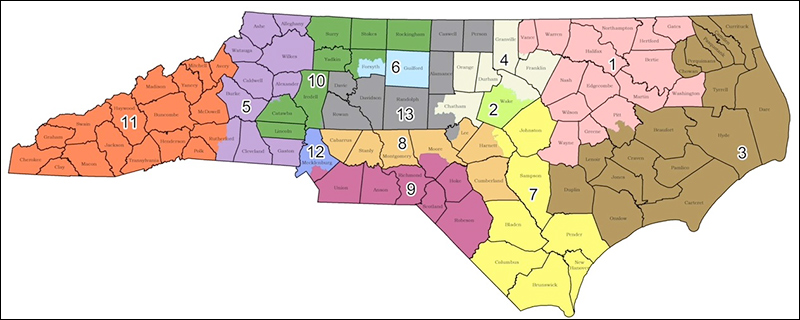By Jim Ellis
May 21, 2021 — With the new reapportionment map public and the states gaining congressional districts now certain, we can begin to speculate where the new CDs might land. Today, we look at North Carolina, which continues to be one of the most important states from a national redistricting perspective.
The Census Bureau’s apportionment report, released on April 26, almost five months after their Jan. 1 deadline, contained the smallest transfer of congressional seats since the World War II era.
Just seven seats are moving from one state to another. As mentioned above, one of the recipients is North Carolina, the state that came the closest to gaining in the last census, missing by just a few thousand people. Today, we speculate as to how a new North Carolina congressional map might unfold.
The 2020 individual state population data has not yet been distributed and is not expected until October, apparently at the earliest. Once the specific state data is made public, the redistricting process can begin, but for now we can only use the latest available data (July 2019) for estimation purposes.
In examining the population numbers for each of the 13 current North Carolina congressional districts, we see that all must shed population to reach the state’s Census Bureau target number of 746,711 individuals, hence, the reason for the Tar Heel State gaining a new district.
In North Carolina, the state legislature has sole jurisdiction over redistricting. The governor, in this case Democrat Roy Cooper, has no veto power over the maps both houses jointly produce. This means the Republicans will control the process since they hold majorities in both the state House and Senate.
No matter what map is drawn, we can count on seeing post-redistricting litigation. In the previous decade, the courts twice altered the original map because of various lawsuits. The final iteration broke 8-5 in favor of the Republicans after the state Supreme Court redrew sections of the state and in effect awarded two previously Republican seats in Raleigh and Greensboro, respectively, to the Democrats.
We can expect the Republicans to make major adjustments in these areas particularly since the party gained seats, including the chief justice position, on the high court in the 2020 election. Former Chief Justice Cheri Beasley lost her election by just 401 votes statewide and is now an announced candidate in the open US Senate race. The chief justice position is highly important in the redistricting process because it is this individual, now Republican Paul Newby, who will select the jurists comprising any three-judge panel necessary to hear redistricting cases.
The most stable seats are the ones in the Old North State’s far eastern and western points. In the east, expect little movement for Reps. G.K. Butterfield (D-Wilson; District 1) and Greg Murphy (R-Greenville; District 3). Both of these CDs must shed the least amount of population of the current 13 districts.
The three districts that comprise western North Carolina, CDs 5, 10, and 11, which Reps. Virginia Foxx (R-Banner Elk), Patrick McHenry (R-Lake Norman), and freshman Madison Cawthorn (R-Hendersonville/Asheville) hold, will likely remain generally intact with probably less than a cumulative 80,000 people moving eastward.
The largest growth areas, not surprisingly, are in the Raleigh and Charlotte metropolitan areas. The largest district is Rep. Alma Adams’ (D-Charlotte) 12th CD that is wholly contained within Mecklenburg County.
The two most over-populated seats in the Research Triangle area, Districts 2 (freshman Rep. Deborah Ross; D-Raleigh) and 4 (Rep. David Price; D-Chapel Hill) will shed significant population, which will likely move to the south unless the new seat is placed in this area.
The other districts in the Charlotte metro area, the 8th and 9th of Reps. Richard Hudson (R-Concord) and Dan Bishop (R-Charlotte), respectively, and Rep. David Rouzer’s (R-Wilmington) 7th CD also must shed significant population, which means, along with a large 150,000-plus population release from Rep. Adams’ district, that the new seat might have to be placed in this region.
Sixth District freshman Rep. Kathy Manning (D-Greensboro) and Congressman Ted Budd’s (R-Advance) 13th CD, which will be open since he has announced his US Senate candidacy, also have to shed individuals and will do so presumably to the south, thus giving us more reason to believe that the new seat is likely destined for the Charlotte metropolitan area. It is probable that the 6th and the 13th will maintain their current partisan allegiance.
In redistricting, maps can be drawn in many ways, and the above description is based solely on population trends and geography. The situation could also significantly change once the final census numbers are released and understood. With Republicans in clear control of the re-mapping process, it is reasonable to assume that at least the new 14th District, in addition to their currently held seats, will be favorable to an eventual GOP nominee.

